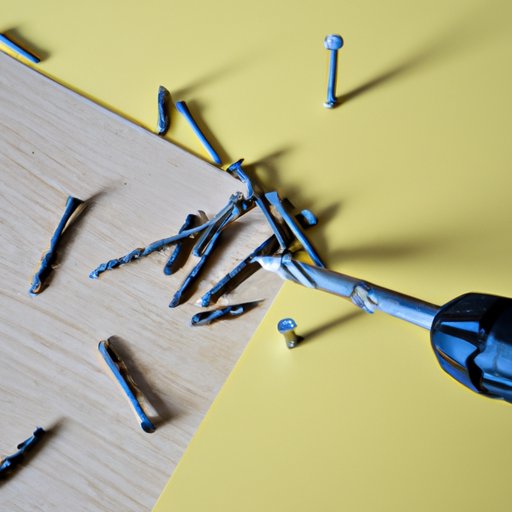Introduction
Have you ever encountered a stripped screw? It’s a common problem that can be incredibly frustrating. Stripped screws can be difficult to remove, and the more you try, the worse it can get. But don’t fret, in this article, we will provide you with 7 methods for removing stripped screws.
Whether you’re a DIY enthusiast, a carpenter or simply working on your home projects, these methods will be very helpful. We will explain each method, discuss how it works and provide clear step-by-step instructions. So, let’s get started!
Method 1: Try Using Rubber Bands
The first method involves using rubber bands. This method works exceptionally well and is easy to execute. The rubber band provides grip and can help you gain traction to twist the screw out of its position. Here’s how you can do it:
- Place a rubber band flat on top of the stripped screw.
- Use the screwdriver and push down as you turn it anticlockwise.
- The rubber band will provide additional grip and allow the screwdriver to get a better grip on the screw.
It’s important to note that you should use a sturdy screwdriver to prevent it from bending or breaking under the pressure.
Method 2: Use a Screw Extractor Tool
If the rubber band method didn’t work for you, don’t worry. Our second method involves using a screw extractor tool. This method is perfect for larger screws, and it’s easy to use. Follow the instructions below:
- Select the proper size extractor bit for the screw.
- Insert the extractor bit into your drill and turn it counterclockwise.
- The extractor bit will grip the screw and unscrew it from its position.
It’s crucial to note that you must be careful while handling the extractor bit to ensure it doesn’t strip or break while in use.
Method 3: Heat the Screw
Heating the screw is another effective way of removing stripped screws. The heat expands the metal of the screw, making it easier to loosen. Here’s how you can do it:
- Heat the screw with a lighter or a heat gun for 15-20 seconds.
- Use a screwdriver to remove the stripped screw slowly. The heat will help the screw turn out easily without too much force.
- Repeat the heating process until the screw has been completely removed.
You should be careful while using this method not to set anything on fire or overheat the screw and damage the surrounding material.
Method 4: Use a Left-Handed Drill Bit
Our next method involves using a left-handed drill bit. This method is ideal for screws that have not been completely stripped, and the drill bit helps to loosen the screw from its position. Follow the instructions below:
- Select a drill bit that is smaller than the screw you want to remove.
- Put the drill in reverse.
- Drill slowly into the screw, the bit must grip the screw.
- The drill bit will twist the screw counterclockwise loosening the screw and extracting it out of its position.
It’s essential to note that the drill must be in reverse, or it could ruin the screw, making it nearly impossible to remove.
Method 5: Use Pliers
If you don’t have a drill or if the stripped screw is in a location too tight for regular tools, you can use pliers for removal. Follow the steps below:
- Choose a pair of pliers that best fits the screw head.
- Grip the screw with the pliers firmly.
- Slowly turn the screw anti-clockwise while still gripping it with the pliers.
- The screw should slowly come out of its position
It’s important to note that you may need extra force to loosen the screw if it’s tight. Apply steady pressure while turning the screw to avoid damage to the surrounding material.
Method 6: Tap the Screwdriver
If you don’t have access to any power tools, you can try tapping the screwdriver into the head of the screw. This method sets the screwdriver into the screwhead better to help apply more turning force and loosen the screw. Follow the instructions below:
- Place the screwdriver in the middle of the screw.
- With a hammer or mallet, rap the end of the screwdriver gently, just enough to move it further into the screwhead.
- Turn the screwdriver in anti-clockwise motion, the screw should come loose and can be removed.
It’s essential to note that this method requires accuracy and a gentle tap. Oil can be applied to the screw if it is still tight.
Method 7: Use Vinegar or Lemon Juice
Our final method uses household acid, vinegar or lemon juice. This method will work best for corroded screws. Here’s how you can do it:
- Soak the screw with vinegar or lemon juice for an hour or two.
- Use a flat-head screwdriver to remove the screw from its position.
It’s important to note that you may need to apply extra force while turning the screw if it’s tight. Be careful not to strip the screw further or damage the surrounding material.
Conclusion
As you can see, there are many practical solutions for removing stripped screws, even if you don’t have any specialized tools. Be mindful of the surrounding materials, keep the work area clean and be patient. By using the right method, you can get those frustrating screws out in no time.
Remember to select the appropriate method based on the screw that needs to be removed. By following these seven methods, you’ll be sure to have the right one for the job.
If you have any other tips or tricks for removing stripped screws, please share them with us in the comments below.
